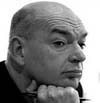 |
New York Architecture Images-New York Architects Jean Nouvel |
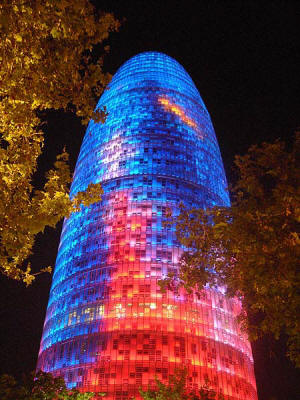 Torre Aigües de Barcelona (Agbar), Barcelona 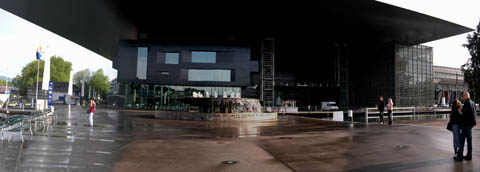 Culture and Convention Center (2000) in Lucerne 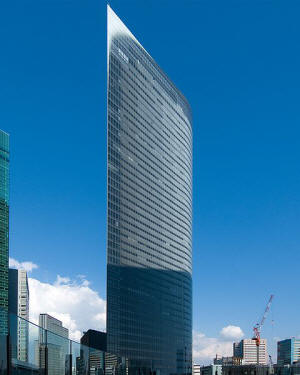 Dentsu Building (1998) in Tokyo 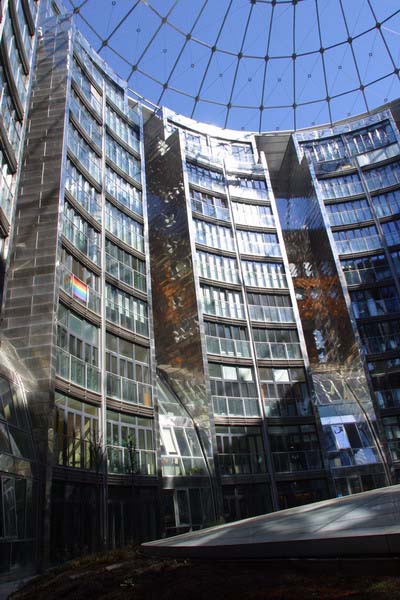 Gasometer A (2001) in Vienna 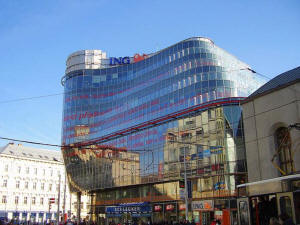 Zlatý Andel (2001) in Prague 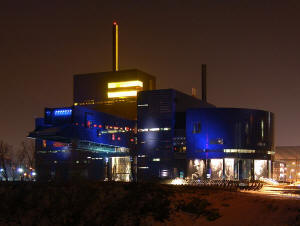 Guthrie Theater (2006) in Minneapolis 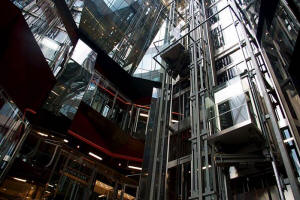 One New Change (2010) in London 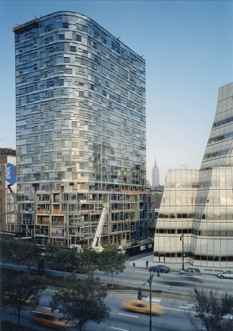 100 Eleventh Avenue, Chelsea, NYC. |
|
|
Surface Tension Jean Nouvel and the art of the façade. by Paul Goldberger November 23, 2009 When you catch your first glimpse of 100 Eleventh Avenue, a new apartment tower in Chelsea designed by the French architect Jean Nouvel, its curving façade, an abstract arrangement of windows slanting in multiple directions, looks like a gimmick. The building clatters; it jangles like a bracelet. Beside the smooth, milky-white exterior of Frank Gehry’s I.A.C. Building, across Nineteenth Street, it seems nervous, and even the architect’s description of it, “a vision machine,” smacks of trying too hard. But Nouvel, one of the world’s most famous and prolific architects, is anything but insecure. Often when an architect hits you with razzle-dazzle, it’s because that’s all he’s got. Nouvel’s buildings, however, not only grab you; they get you thinking about architecture in a more serious way. Nouvel, who is sixty-four, won the Pritzker Prize last year, but his name is still probably better known than any of his buildings—particularly in the United States, where he hadn’t built anything until 2006, when his Guthrie Theatre, in Minneapolis, opened (a brawny building sheathed in dark-blue steel, with a large cantilever overlooking the Mississippi). Furthermore, it’s not easy to characterize his work; his buildings share no immediately recognizable style. Yet almost all of them have a harsh, tough beauty and represent an attempt to elicit an emotional response through the provocative use of modern materials. Taschen has published a grandiose monument to his career—“Jean Nouvel by Jean Nouvel: Complete Works 1970-2008” ($200)—and when you leaf through the book you see certain themes recurring, especially a fascination with façades and with blurring the boundary between inside and outside. The sheer variety of the work keeps you turning the pages: the book is less a catalogue raisonné than a story in which you want to see what the protagonist is going to do next. Nouvel was relatively unknown outside Paris until the mid-nineteen-eighties, when he won the design competition for one of François Mitterrand’s Grands Projets, the Arab World Institute, on the Left Bank of the Seine. Nouvel devised a façade with thirty thousand light-sensitive metal diaphragms behind glass. Opening and closing like camera shutters, the diaphragms were designed to control the penetration of light into the building, but they also mimic the perforations of a mashrabiya, a kind of latticework screen common on the windows of Arabian buildings. Rather than simply coming up with a pastiche of Arabic architecture, like the Paris Mosque, Nouvel evoked an Arabic aesthetic with a distinctively high-tech, Western building. Soon afterward, Nouvel designed his so-called Tour sans Fins (Tower Without End), for La Défense, the skyscraper district at the western edge of Paris. A hundred-story cylinder whose glass exterior became lighter and more transparent as it rose, the building was designed to disappear into the clouds. The project was never built, but it marked an important step in Nouvel’s fascination with a façade’s potential for ambiguity. The more recent Cartier Foundation, also in Paris, is a glass box whose façade extends beyond the sides of the building. In front of the building is a garden and, in front of that, a freestanding plane of glass, intentionally blurring the distinction between the garden wall and the building wall. In Barcelona, Nouvel’s Torre Agbar, a round skyscraper that narrows toward a rounded top, has an experimental façade of a different sort. The building’s shape bears an obvious resemblance to Norman Foster’s so-called Gherkin building, in London, but the differences are telling. Whereas Foster’s tower is crisp and light, Nouvel’s—covered with thousands of tiny panes of glass that open and close like casement windows, and reveal a pattern of flowing colors behind them—is so richly textured that it looks as if it were made not of glass at all but of some indeterminate material. Nouvel has called it “a mirage.” In a New York condominium market reshaped by the likes of Richard Meier and Charles Gwathmey, it was inevitable that developers would want to hire Nouvel, and 100 Eleventh Avenue is, in fact, his second New York apartment building. The first, a glass block at 40 Mercer Street, in SoHo, that was finished in 2007, is surprisingly understated. Nouvel, it seems, was no match for the Landmarks Preservation Commission. The building has a front of blue glass set into steel frames, and its scale and its texture fit gracefully into the nineteenth-century streetscape. But it’s so well mannered that it doesn’t feel entirely like Nouvel. On Eleventh Avenue, there wasn’t a clear urban fabric for Nouvel to fit into: to the south and east are Gehry’s building and the development surrounding the High Line; to the north are the nondescript foothills of midtown. The site is L-shaped, and the inside of the L, facing midtown, is austere: windows of varying sizes and shapes are punched into a solid wall of black brick. Nouvel saves his showmanship for the other side, the façade rounding the corner of Eleventh Avenue and Nineteenth Street. It is made up of enormous prefabricated metal grids, each containing an arrangement of windows of different sizes and shapes, with the glass angled in every conceivable direction. When the whole thing is put together, it looks like a vast, reflective Mondrian, or like huge glass shingles, randomly assembled. Each of the angled windowpanes—there are more than sixteen hundred—reflects light slightly differently, making the building glitter like sequins in the afternoon sun. If you are tired of the way every modern building feels flatter and thinner than the one before it, well, so is Jean Nouvel. The curving façade maximizes the number of apartments that have river views. Nouvel, unlike many architects who responded to the call of developers to design high-end condominiums when the market was still white-hot, paid serious attention to the interior. No one can accuse him of tweaking an ordinary building and slapping his name on it to sell apartments. Talking to an interviewer once about working for developers, Nouvel said that if a building is “only the result of an economic situation, it can’t have meaning.” The apartments are awash with light, arrestingly refracted by the irregular pattern of the windows, and Nouvel designed every detail, from squared-off sinks and bathtubs, with faucets that operate by touch, to rolling stainless-steel kitchen cabinetry. There is a dark, serene lobby with windows giving onto a garden at the rear, in which trees sit in midair on planters built into the main structure. There is a seventy-foot swimming pool that is both indoors and outdoors: it starts in the basement and extends into the lower level of a garden courtyard. For all the attention this building is getting, Nouvel is probably best known in New York for a building that he has not built, or, at least, not yet—an eighty-two-story tower planned for a tiny site on West Fifty-third Street beside the Museum of Modern Art. As originally designed, the tower was to rise to twelve hundred and fifty feet, the height of the Empire State Building. But the planned building was anything but bulky: around a slender glass tower, Nouvel wrapped a spire of steel bracing that extends beyond the building’s floors to form a needle-thin peak. The building’s neighbors were aghast, viewing it as an unnecessary intrusion into an already overcrowded part of midtown Manhattan. In October, the City Planning Commission approved the project but insisted that Nouvel take off two hundred feet, removing the top of the steel frame. It’s a bad compromise: the tower, still too big to satisfy the neighbors, is also a lot less graceful. The chairman of the commission, Amanda Burden, said she didn’t feel that Nouvel’s top was good enough to be in the company of the Empire State Building, so the commission decided that it shouldn’t challenge that building’s preëminence in the midtown skyline. The commission wanted, in effect, to landmark the sky. Kurt Vonnegut once described Manhattan, ironically, as “Skyscraper National Park,” and it’s as if the commission had taken him literally. The trouble is that it’s impossible to keep a Nouvel design and eviscerate it at the same time. Nouvel’s designs, for all their bombast, are conceived as a whole. You can take them or leave them, but tone them down and you’ve missed the point. Read more: http://www.newyorker.com/arts/critics/skyline/2009/11/23/091123crsk_skyline_goldberger#ixzz2CHgZsofk |
|
|
links |
|